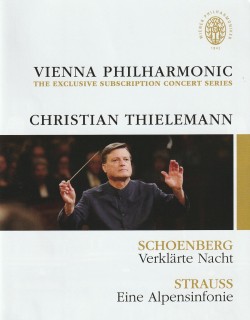 Schoenberg – Verklärte Nacht; Strauss – Eine Alpensinfonie
Schoenberg – Verklärte Nacht; Strauss – Eine Alpensinfonie
Vienna Philhamonic; Christian Thielemann
Cmajor DVD 766908 (naxos.com/CatalogueDetail/?id=766908)
Both of these celebrated tone poems were initially conceived in the final year of the 19th century. Schoenberg composed his string sextet in a mere three weeks; it took Strauss sixteen years and several false starts to complete his far more massive work. Curiously, both works begin with a similar slowly descending scale pattern.
Schoenberg’s work is presented here in his 1946 version for string orchestra, which is itself a minor revision of an earlier edition from 1917. A performance with a full string section (including eight double basses) always carries with it a risk of bloviation, but fortunately Christian Thielemann, with the sensitive assistance of concertmaster Rainer Honeck, manages to preserve the intimacy of the original chamber setting while providing moments of high passion when appropriate. Altogether, it’s a beautiful performance indeed.
The stage is packed to the gills in the massively scored Strauss tone poem, which requires the services of 125 players including such niceties as 12 off-stage horns, heckelphone, four-manual organ, two timpanists and quadruple winds. No other orchestra in the world has quite the same luscious sound as the Wiener Philharmoniker. This is due in large part to the unique construction of the trumpets, horns, clarinets and oboes that thrive only in Vienna. One might call this an “historically informed” performance, except that it has changed so little in the 154 years of the orchestra’s existence.
Thielemann’s conducting of this flawless Strauss performance is largely non-interventionist compared to his occasional passionate gestures in the Schoenberg. In fact, it’s quite reminiscent of videos I have seen of Strauss’ own seemingly uninvolved conducting. They both lead with minimal gestures, but believe me, they have their eyes on you. Technically, I greatly appreciated the titles provided in the DVD identifying the 22 programmatic episodes of the work. The video quality itself is on the garish side, suitable for television transmission, and the camera work is excellent overall.
The fearsome Vienna Philharmonic is, notoriously, an orchestra without a permanent conductor that has their own way of doing things. I was reminded of the time they performed in Toronto at Roy Thomson Hall where, sitting in the choral balcony, I couldn’t help but notice how they consistently responded a microsecond behind the beat of the conductor, Franz Welser-Möst. Later, in the company of Robert Aitken, we met up with the flute section at a local pub where Bob asked them what they thought of their conductor for the evening. After some initial hesitation, one player volunteered, “We like him. He doesn’t get in the way!” That should tell you all you need to know.



